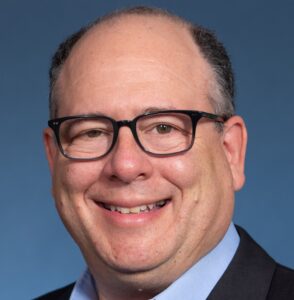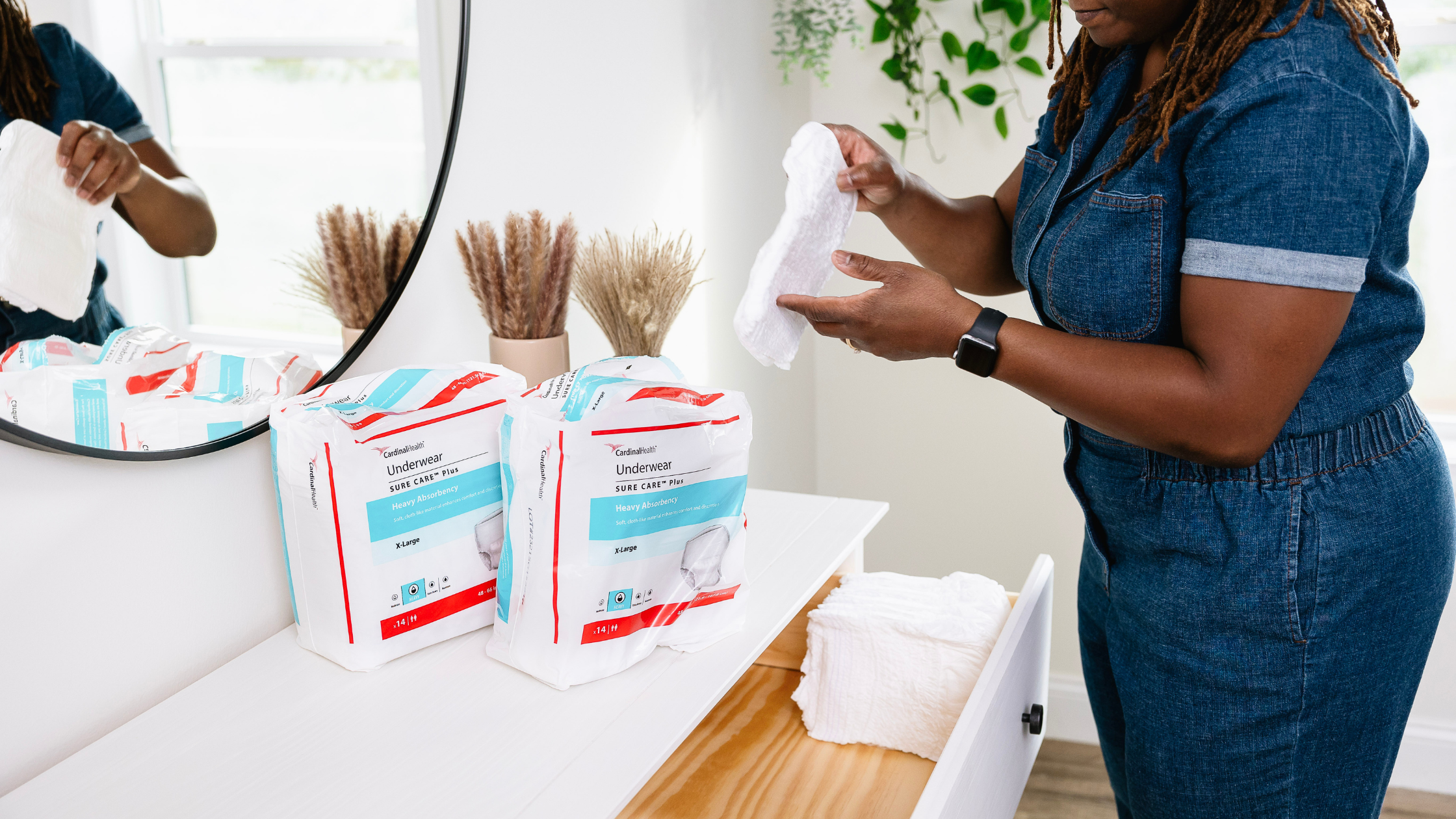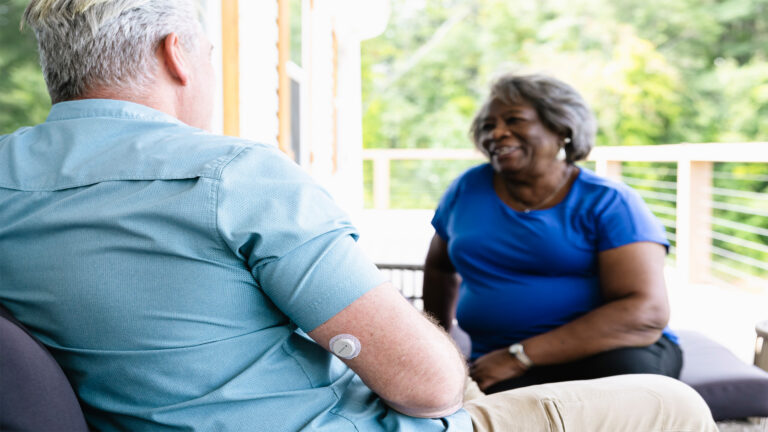This content has been reviewed for accuracy by Mike Cantor, Chief Medical Advisor at Aeroflow Health.
Dive into our blog inspired by our webinar, “Common Vs. Normal: Building A Sustainable Strategy For Incontinence Management,” to learn about the significant changes occurring in the realm of continence care and how Aeroflow is actively engaged in supporting patients living with incontinence. For more comprehensive insights, don’t miss the chance to watch the webinar playback.
Table of Contents
What is urinary incontinence? How common is it? How does it affect people’s lives?
Aleece: Urinary incontinence is the involuntary loss of urine from the bladder. Urinary incontinence can be broken down into 5 types:
- Urge incontinence: This is where someone has an urgent/sudden intense need to use the restroom. This person would have an involuntary loss of urine.
- Stress incontinence: Occurs when there is increased stress or pressure from the abdominal cavity is applied to the pelvic floor muscles and bladder. Some may experience loss of urine during exercise or a sneeze.
- Overflow incontinence: Overflow incontinence happens when the bladder cannot hold any more urine, and it usually happens to somebody who has incomplete bladder emptying. We usually would see this potentially in someone who’s had an enlarged prostate. I always explain it to my patients as if you’ve got a glass holding water. It can only hold so much at one time before overflowing. I also commonly see this type for female-identified folks who have a prolapse of that bladder where they’re not able to empty their bladder as much.
- Functional incontinence: This type is for someone who has a physical or cognitive limitation that disrupts their ability to get to the restroom in time. For example, someone who has severe arthritis or someone who is using an assistive device may take a little bit longer to get to the restroom. This type is also commonly found among those with dementia or Alzheimer’s disease.
- Mixed incontinence: This type can be any of the above types of incontinence. I explain this to my patients by drawing a Venn diagram and showing how all of the types can overflow.
Regarding who incontinence impacts the most, we are going to see this more among those who identify as female, especially as they age. However, incontinence really can affect anyone. We assume that incontinence only happens to those who are in their 60s-70s or children learning to potty-train, but really, it impacts everyone. I was recently talking to a group of female adolescent athletes struggling with incontinence, and I think that we can forget how many female adolescents are experiencing urinary incontinence. For females, the situations that will increase their risk rate are going to be pregnancy and the type of delivery. Menopause can also cause incontinence. Incontinence affects over 25 million individuals across the U.S., and it does not discriminate. Unfortunately, I do think that because of social determinants of health, some populations are significantly more impacted than others. 1 in 4 men admit to regular bladder leaks and 1 out of 2 women report experiencing bladder leaks. When we think about how incontinence impacts lives, people’s dignity and social lives are under fire. Many of the following questions are asked:
- Do I smell?
- Will I be able to find a restroom nearby while I am out?
- If I have to leave during a movie, will I miss out on things?
- Will I have access to my products when I need them?
These all can greatly impact mental health. I don’t think we truly grasp and talk about the way incontinence impacts people’s mental health and how it limits people from getting out and doing things. This limitation can lead to anxiety, depression, stress and more. People have lost jobs because of having to leave their desks so frequently to use the restroom. There is a great fear around potentially having an accident and then the shame that it could lead to. There is a stigma around incontinence, and we need to be able to talk more freely about it, as it has happened to all of us at some point. Normalizing incontinence isn’t necessarily the goal, but rather, it is to communicate that it is common and not normal, but there are things we can do about it.
What are incontinence products? Which health plans cover these products and what is covered?
A2: Mica: At a fundamental level, a lot of what we deal with with incontinence management is your disposable wearable incontinence products. You might hear them referred to as “Depends” on the kind of protective underwear style, or you may hear them colloquially referred to as “diapers,” although we try not to use the word diaper because of dignity issues that it can create with the adult population, and then you will also hear about bladder control pads which are often referred to as a Poise pad, typically for a female patient with lite to moderate incontinence. Aeroflow Urology prides itself in providing these types of products to patients through insurance. We don’t treat the underlying condition but rather help individuals manage the symptoms as best we can relative to each person’s unique needs. Having worked with direct patient care for more than 10 years, I would like to highlight that each patient we work with requires a very nuanced approach to care. Our teams like to take a holistic approach to consider what else might be going on in a patient’s life that will impact their incontinence product needs. For example, our team will ask questions like:
- Are they in the process of losing or gaining weight?
- Is their mobility diminishing?
- Are they on any medications?
We strive to ensure that each patient gets the product that best suits their needs. Since most of these products are primarily available over the counter, we see many patients self-managing, and often, they aren’t purchasing the best product to help manage their instances of incontinence. I will also say that is a really underrated aspect of the Medicaid population. To speak to the insurance piece, the only payor category in the United States that currently covers incontinence products is the Medicaid population and so we at Aeroflow Health concern ourselves primarily with identifying patients within the Medicaid and Medicaid Dual population who have coverage of these products and then providing a solution for them. Though Medicaid represents a considerable percentage of insured lives in America, it certainly leaves a huge delta between the total number of people who may have this condition and people who do not have a framework to receive the products they need.
What are the most common misconceptions about incontinence products?
Mica: I can give you a very common example of one we deal with daily and it’s around a Brief product, which is a product with tabs. If someone has fecal incontinence, a brief product will always be the most appropriate product to help manage this condition, but we see so many challenges with patient adherence because of the dignity aspect of accepting a product with tabs. This type of product can be infantilizing and can make someone more acutely aware of their condition, which can cause shame. This type of scenario often leads to patients self-managing with protective underwear or, even worse, with something like a bladder control pad. Our team has to have hard conversations with patients to let them know that the products they are currently using might not be clinically best for their condition. Even despite having these conversations, we see significant adherence complications in getting patients to accept those products.
Ryan: Aeroflow is passionate about trying to normalize the conversation of incontinence and raising more awareness to how many people it does affect. We also hope to educate on the solutions that are available to people so that they don’t be limited in their lifestyle.
How does Aeroflow overcome the barrier of keeping in contact with patients? How do you continue to engage the patients?
Mica: For Aeroflow Urology, it’s taking a lot of extra time and care to be intentional with patients during the intake phone call. When someone reaches out to us, that initial call can often be a 30-45 minute conversation. We not only walk the patient through the products available but also ask questions like:
- Do you have a mobile number where we can reach you?
- What is your preferred method of communication?
- Who is your emergency contact?
- Do you have multiple addresses?
- Do you have someone who assists in your care?
Going the extra mile to obtain those supplemental data points is very helpful! For the Medicaid population, there is a higher percentage of those using prepaid cell phones and lower utilization rates of email, so having all of this additional information can be helpful in reaching patients if they become hard to reach. We also see patients who experience disruptions in their coverage, and we have to help explain to the patients the details of their insurance. So, really, we’re expanding our depth of explanation from just incontinence product knowledge to health insurance education because that’s what it takes to keep these patients engaged for the long haul.
Regarding engagement, incontinence products are a monthly cycle, which means we’re in contact with our patients at least once a month. It may be as simple as checking in to see if they need a resupply, but we’re reaching out to all of our patients monthly. We often find that when we obtain a patient’s physician information and reach out to the doctor to let them know that the patient is interested in receiving incontinence products through insurance, often that is the first time the physician has heard that their patient is experiencing incontinence. This goes to show that, left to their own devices, many patients are suffering in silence, self-managing as best they can, and because they aren’t engaging with their physician, they aren’t going through the additional screenings. One of the most impactful ways that Aeroflow partners with health plans is by encouraging patients to engage with their providers and insurance companies. We have a proximity that the payor often doesn’t have.
Access to care is often not evenly distributed. How does health equity impact incontinence care rates?
Mica: I will say that very few people are incontinent just because they are incontinent. There are often interrelated conditions that all play a part in management. Typically, these patients are speaking to so many different specialists that when we ask them who to talk to regarding their incontinence needs, they don’t know who to direct us to. This is where I see some challenges from the provider/direct patient care of understanding and adherence.
Aleece: Access to care has gotten a little better since COVID-19 and the rise of telehealth and telemedicine. However, I do think that there is value in seeing someone in person so that I can check urine samples and see how much they have left in their bladder. For me, I am always looking at what resources are available in the community for my patients. Is it a mobile health unit or home healthcare? A lot of the time, people are not aware of the resources available to them. I function as a matchmaker sometimes just to raise awareness of the resources available. There is also a huge shortage right now for urologists who can compact this access problem. I have to really get creative on ways to provide access to patients.
Ryan: Aeroflow recognizes that there is a transportation need as it relates to access, and we’re seeing that Centers for Medicare & Medicaid Services (CMS) and many Medicaid plans are trying to determine those Social Determinants of Health and the insecurities that are being created. This is an opportunity for us internally to help identify these data points and relay those back to health plans. I think there is a lot of opportunity around interoperability as we think about caring for these patients holistically.
How do we treat incontinence, and how often does successful treatment occur?
Aleece: I am so optimistic. I usually say that we can typically make most patients better. What the degree of better looks like usually depends on each individual, their diagnosis, and what their support system looks like. I really recommend patients see a pelvic floor therapist. There can be some barriers when we talk about occupational therapy or physical therapy subsets. Sometimes, insurance won’t cover these visits, or you’re limited in your visit allowance. For example, if you have 30 visits a year and just had knee surgery, you will have post-surgery therapy to help regain movement. Just this one need could use up all of the allotted visits. These types of physical therapy sessions are often taking precedence for people rather than that of pelvic floor therapy. I have to meet a lot of people where they are for this. There are some oral medications to help, but many people are already taking several other medications, so I have to ask myself if they want to start taking another. Medications are also an additional cost and could complicate the usage of being taken with other pre-existing medicines. Individual treatment and ongoing communication are crucial to successful treatment. Mental health also has a huge impact on incontinence treatment for patients. There is a lot of anxiety, stress, and depression that can come along with incontinence, so pairing patients with a mental health therapist can help streamline successful treatment.
"Aeroflow has allowed me to play with my great-grandchildren, and to go to the grocery store without staying close to a bathroom. My daughter no longer has to be my shopper. Not to mention the money they are saving, which can be used for utilities."
Liz H.

Michael Cantor, M.D.
Dr. Mike Cantor is a geriatrician and attorney who has extensive experience designing and implementing value-based care, quality improvement, and care management programs for healthcare providers and health plans. He works as a fractional (part-time) Chief Medical Advisor for Aeroflow Healthcare, Uber Health, and other technology-enabled health services companies, value-based care organizations and digital health companies. Previous roles include: CMO for Bright Health Plan, an innovative health
insurer; CMO for CareCentrix, a leading outsourced home health, durable medical equipment, and post- acute care benefits manager recently acquired by Walgreens; and CMO for the New England Quality Care Alliance (NEQCA), the physician network affiliated with Tufts Medical Center, where he implemented network-wide quality improvement and care management programs for 150,000 managed care lives. He trained in internal medicine at Beth Israel Hospital in Boston and did his geriatrics fellowship at Harvard Medical School. He has degrees in law and medicine from the University of Illinois.

Ryan Bullock
Ryan serves as Chief Strategy Officer at Aeroflow Health, a premier nationwide provider of durable medical equipment. In his current position, Ryan oversees strategic operations, corporate development and government relations. For over 14 years, Ryan has provided exceptional leadership, management and vision to Aeroflow, resulting in incredible growth and profitability for the company. Ryan holds a Bachelors of Science degree in Electronic Engineering from Western Carolina University and resides with his family in the beautiful mountains of Asheville, North Carolina.

Aleece Fosnight, MSPAS, PA-C, CSC-S, CSE, NCMP, IF
Aleece serves as the Medical Advisor for Aeroflow Urology and is a board-certified physician assistant specializing in sexual medicine, women’s health, and urology. In 2019, Fosnight opened up her own private practice, the Fosnight Center for Sexual Health, and implemented the sexual health grand rounds curriculum at her local hospital and residency program. Fosnight is also the founder of the Fosnight Foundation, a non-profit organization dedicated to the education and training of professionals in the sexual health field and providing funding for access to healthcare services in her local community.

Mica Phillips
Mica serves as Vice President of Aeroflow Urology, a subsidiary of Aeroflow Health that is a leading provider of high-quality continence care supplies through insurance. He brings creativity to a sometimes stagnant and complacent industry and tries his best to uncomplicate the complex world of Insurance. He is a graduate of the University of North Carolina and holds a Bachelor’s degree in English. In addition to his daily responsibilities, he’s contributed to numerous articles for online journals regarding senior care, incontinence, and navigating insurance benefits.





